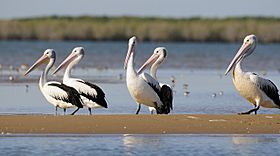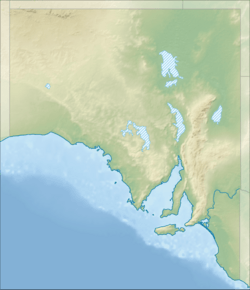Coongie Lakes facts for kids
Quick facts for kids Coongie Lakes |
|
|---|---|

Up to 100,000 Australian Pelicans have been recorded at Coongie Lakes
|
|
| Location | Far North, South Australia |
| Coordinates | 27°15′41″S 140°09′25″E / 27.26139°S 140.15694°E |
| Type | Salt lake |
| Basin countries | Australia |
| Managing agency | Department of Environment, Water and Natural Resources |
| Designation | Ramsar Site |
| Surface area | 21,790 km2 (8,410 sq mi) |
| Designated: | 15 June 1987 |
| Reference #: | 376 |
The Coongie Lakes is a special freshwater area in the Far North of South Australia. It's a huge wetland system, covering about 21,790 square kilometers. That's like a giant natural water park!
This amazing place is about 1,046 kilometers north of Adelaide city centre. It includes many different water spots like lakes, flowing channels, billabongs (which are like small, still lakes), and areas that flood often.
The Coongie Lakes sit on the floodplain of Cooper Creek. This creek usually flows through a desert, but after big rains, it can fill up and even reach Lake Eyre. Because of its importance, the Coongie Lakes are recognized internationally by the Ramsar Convention and nationally in Australia.
Contents
Discovering Coongie Lakes: Where is it?
The Coongie Lakes are found in the very top-right corner of South Australia. It's about 1,046 kilometers north of Adelaide. Imagine drawing a triangle on a map; that's roughly the shape of this wetland system.
The top point of this triangle is near Lake Moorayepe. The bottom-left point is near Marion Hill. The right point is right on the border between South Australia and Queensland, close to the town of Innamincka. This whole area covers about 21,790 square kilometers.
The land around Coongie Lakes is mostly dry desert. Not many people live here. The main activities are raising cattle, finding oil and gas, and more recently, tourism. Some parts of the wetlands only fill with water after heavy rains. Other parts stay wet for a short time after floods. But some areas have water almost all the time. This land has been home to the Yandruwandha, Yawarrawarrka, Ngamini, and Dieri people for a very long time.
Plants and Animals: Who Lives Here?
The areas around Cooper Creek and Coongie Lakes that get flooded are full of trees like river red gums and coolibahs. You might also see thick bushes called lignum.
The nearby stony plains, called gibber plains, have some Mitchell grass. In the dune areas, you'll find plants like Dodonaea, sandhill wattle, and sandhill canegrass.
Wildlife in the Wetlands
When big floods happen, usually from heavy rains in Queensland, the area comes alive! Plants grow quickly, and many animals arrive. This is especially true for waterbirds. Huge numbers of ducks, cormorants, pelicans, ibises, spoonbills, herons, and waders gather here. They come to eat and have their babies. Once the water goes down, they spread out again.
You can also find mammals like red kangaroos and dingos in the area. In the wetlands, there are rakali, which are native water rats. Many different frogs and reptiles live here too, including the famous inland taipan, one of the world's most venomous snakes.
Protecting Coongie Lakes: Why is it Special?
The Coongie Lakes wetland system is very important, so it has special protected status.
International and National Recognition
It's recognized by the Ramsar Convention, an international agreement to protect wetlands. It was listed as a Ramsar site on June 15, 1987. It's also listed in "A Directory of Important Wetlands in Australia" (DIWA).
Even though the Ramsar Convention is an international treaty, the South Australian government is in charge of managing this wetland system. The Department of Environment, Water and Natural Resources handles its care.
Protected Areas in South Australia
Several protected areas are found within the Coongie Lakes system. These include the Innamincka Regional Reserve, the Malkumba-Coongie Lakes National Park, and the Strzelecki Regional Reserve. These areas help keep the unique environment safe for future generations.
A Bird Paradise: Coongie Lakes Important Bird Area
A specific part of the Coongie Lakes, covering about 593 square kilometers, is known as an important bird area. This means it's super important for birds! Birdlife International has identified it because it supports:
- More than 1% of the world's population of 12 different types of waterbirds and shorebirds.
- Populations of special birds like the vulnerable Australian painted snipe and the near-threatened blue-billed duck.
- Other unique birds that live only in dry areas.


